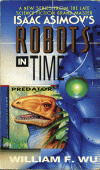Robots and Empire by Isaac AsimovRobots and Empire by Isaac Asimov
At this point if you have not read The Caves of Steel, The Naked Sun, and The Robots of Dawn, this review will contain plot spoilers for those novels. I highly suggest reading both of them before even reading this review.
The events in Robots and Empire take place about 200 years after The Robots of Dawn. Elijah Baley’s victory in exonerating Dr. Han Falstofe in the death of R. Jander Parnell secured his powerful position in Auroran government. Kelden Amadiro which was implicated in the death of Jander hasn’t forgotten his bitter defeat. With his support Earth was allowed to develop its colonization plans. The number of Settler worlds is increasing, and no new settlement from Spacer worlds has taken place. Actually, Solaria has severed all contact with everyone and is rumored to be empty. (more…)







